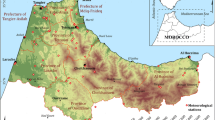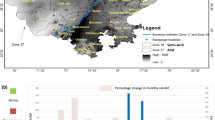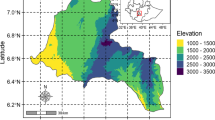Abstract
Global climate change is one of the most serious issues we are facing today. While its exact impacts on our water resources are hard to predict, there is a general consensus among scientists that it will result in more frequent and more severe hydrologic extremes (e.g. floods, droughts). Since rainfall is the primary input for hydrologic and water resource studies, assessment of the effects of climate change on rainfall is essential for devising proper short-term emergency measures as well as long-term management strategies. This is particularly the case for a region like the Korean Peninsula, which is susceptible to both floods (because of its mountainous terrain and frequent intense rainfalls during the short rainy season) and droughts (because of its smaller area, long non-rainy season, and lack of storage facilities). In view of this, an attempt is made in the present study to investigate the potential impacts of climate change on rainfall in the Korean Peninsula. More specifically, the dynamics of ‘present rainfall’ and ‘future rainfall’ at the Seoul meteorological station in the Han River basin are examined and compared; monthly scale is considered in both cases. As for ‘present rainfall,’ two different data sets are used: (1) observed rainfall for the period 1971–1999; and (2) rainfall for the period 1951–1999 obtained through downscaling of coarse-scale climate outputs produced by the Bjerknes Center for Climate Research-Bergen Climate Model Version 2 (BCCR-BCM2.0) climate model with the Intergovernmental Panel on Climate Change Special Report on Emission Scenarios (IPCC SRES) 20th Century Climate in Coupled Models (20C3M) scenario. The ‘future rainfall’ (2000–2099) is obtained through downscaling of climate outputs projected by the BCCR-BCM2.0 with the A2 emission scenario. For downscaling of coarse-scale climate outputs to basin-scale rainfall, a K-nearest neighbor (K-NN) technique is used. Examination of the nature of rainfall dynamics is made through application of four methods: autocorrelation function, phase space reconstruction, correlation dimension, and close returns plot. The results are somewhat mixed, depending upon the method, as to whether the rainfall dynamics are chaotic or stochastic; however, the dynamics of the future rainfall seem more on the chaotic side than on the stochastic side, and more so when compared to that of the present rainfall.






Similar content being viewed by others
References
Abarbanel HDI, Lall U (1996) Nonlinear dynamics of the Great Salt Lake: system identification and prediction. Clim Dyn 12:287–297
Arnell NW, Hudson DA, Jones RG (2003) Climate change scenarios from a regional climate model: estimating change in runoff in southern Africa. J Geophys Res 108(D 16):4519–4528
Casdagli M (1992) Chaos and deterministic versus stochastic nonlinear modeling. J R Stat Soc B 54(2):303–328
Chiew FHS, McMahon TA (2002) Modeling the impacts of climate change on Australian streamflow. Hydrol Process 16:1235–1245
Christensen N, Lettenmaier DP (2007) A multimodel ensemble approach to assessment of climate change impacts on the hydrology and water resources of the Colorado River basin. Hydrol Earth Syst Sci 11:1417–1434
Durman CF, Gregory JM, Hassell DC, Jones RG, Murphy JM (2001) A comparison of extreme European daily precipitation simulated by a global and a regional climate model for present and future climates. Q J R Meteorol Soc 127(573):1005–1015
Elsner JB, Tsonis AA (1993) Nonlinear dynamics established in the ENSO. Geophys Res Lett 20:213–216
Farmer DJ, Sidorowich JJ (1987) Predicting chaotic time series. Phys Rev Lett 59:845–848
Fowler HJ, Blenkinsop S, Tebaldi C (2007) Linking climate change modeling to impacts studies: recent advances in downscaling techniques for hydrological modeling. Int J Climatol 27(12):1547–1578
Frei C, Schöll R, Fukutome S, Schmidli J, Vidale PL (2006) Future change of precipitation extremes in Europe: an intercomparison of scenarios from regional climate models. J Geophys Res Atmos 111:D06105. doi:10.1029/2005JD005965
Gilmore CG (1993) A new test for chaos. J Econ Behav Organ 22:209–237
Grassberger P, Procaccia I (1983) Measuring the strangeness of strange attractors. Physica D 9:189–208
Hewitson BC, Crane RG (1996) Climate downscaling: techniques and application. Clim Res 7:85–95
Holzfuss J, Mayer-Kress G (1986) An approach to error-estimation in the application of dimension algorithms. In: Mayer-Kress G (ed) Dimensions and entropies in chaotic systems. Springer, New York
Huth R (1999) Statistical downscaling in central Europe: evaluation of methods and potential predictors. Clim Res 13:91–101
IPCC (2007) Contribution of working group I to the fourth assessment report of the intergovernmental panel on climate change. In: Solomon S, Qin D, Manning M, Chen Z, Marquis M, Averyt KB, Tignor M, Miller HL (eds) Climate change 2007: the physical science basis. Cambridge University Press, Cambridge
Jayawardena AW, Lai F (1994) Analysis and prediction of chaos in rainfall and stream flow time series. J Hydrol 153:23–52
Kennel MB, Brown R, Abarbanel HDI (1992) Determining embedding dimension for phase space reconstruction using a geometric method. Phys Rev A 45:3403–3411
Lee D-K, Kim H-R, Hong S-Y (1998) Heavy precipitation over Korea during 1980–1990. Korean J Atmos Sci 1:32–50
Lim K-H (1997) The linear relationship between monthly precipitation amounts of Korea and time variation of the geopotential height in East Asia and the Pacific during the summer season. J Korean Meteorol Soc 33:63–74
Maurer EP (2007) Uncertainty in hydrologic impacts of climate change in the Sierra Nevada, California under two emissions scenarios. Clim Chang 82(3–4):309–325
Murphy J (1999) An evaluation of statistical and dynamical techniques for downscaling local climate. J Climate 12:2256–2284
Nerenberg MAH, Essex C (1990) Correlation dimension and systematic geometric effects. Phys Rev A 42(12):7065–7074
Olsson J, Niemczynowicz J, Berndtsson R (1993) Fractal analysis of high-resolution rainfall time series. J Geophys Res 98(D12):23265–23274
Packard NH, Crutchfield JP, Farmer JD, Shaw RS (1980) Geometry from a time series. Phys Rev Lett 45(9):712–716
Panofsky HA, Brier GW (1968) Some applications of statistics to meteorology. The Pennsylvania State University, University Park, 224 pp
Porporato A, Ridolfi R (1997) Nonlinear analysis of river flow time sequences. Water Resour Res 33(6):1353–1367
Puente CE, Obregon N (1996) A deterministic geometric representation of temporal rainfall. Results for a storm in Boston. Water Resour Res 32(9):2825–2839
Randall DA (2000) General circulation model development: past, present, and future. Academic Press, San Diego
Regonda S, Sivakumar B, Jain A (2004) Temporal scaling in river flow: can it be chaotic? Hydrol Sci J 49(3):373–385
Rodriguez-Iturbe I, De Power FB, Sharifi MB, Georgakakos KP (1989) Chaos in rainfall. Water Resour Res 25(7):1667–1675
Salathé EP (2003) Comparison of various precipitation downscaling methods for the simulation of streamflow in a rainshadow river basin. Int J Climatol 23:887–901
Schertzer D, Tchiguirinskaia I, Lovejoy S, Hubert P, Bendjoudi H (2002) Which chaos in the rainfall-runoff process? A discussion on ‘Evidence of chaos in the rainfall-runoff process’ by Sivakumar et al. Hydrol Sci J 47(1):139–147
Schreiber T, Kantz H (1996) Observing and predicting chaotic signals: is 2% noise too much? In: Kravtsov YA, Kadtke JB (eds) Predictability of complex dynamical systems. Springer series in synergetics. Springer, Berlin, pp 43–65
Sivakumar B (2000) Chaos theory in hydrology: important issues and interpretations. J Hydrol 227(1–4):1–20
Sivakumar B (2001) Rainfall dynamics at different temporal scales: a chaotic perspective. Hydrol Earth Syst Sci 5(4):645–651
Sivakumar B (2004) Chaos theory in geophysics: past, present and future. Chaos Solitons Fractals 19(2):441–462
Sivakumar B (2005) Correlation dimension estimation of hydrologic series and data size requirement: myth and reality. Hydrol Sci J 50(4):591–604
Sivakumar B (2009) Nonlinear dynamics and chaos in hydrologic systems: latest developments and a look forward. Stoch Environ Res Risk Assess 23:1027–1036. doi:10.1007/s00477-008-0265-z
Sivakumar B, Liong SY, Liaw CY, Phoon KK (1999a) Singapore rainfall behavior: chaotic? ASCE J Hydrol Eng 4(1):38–48
Sivakumar B, Phoon KK, Liong SY, Liaw CY (1999b) A systematic approach to noise reduction in chaotic hydrological time series. J Hydrol 219(3/4):103–135
Sivakumar B, Sorooshian S, Gupta HV, Gao X (2001) A chaotic approach to rainfall disaggregation. Water Resour Res 37(1):61–72
Sivakumar B, Berndtsson R, Olsson J, Jinno K (2002a) Reply to ‘Which chaos in the rainfall-runoff process?’ by Schertzer et al. Hydrol Sci J 47(1):149–158
Sivakumar B, Persson M, Berndtsson R, Uvo CB (2002b) Is correlation dimension a reliable indicator of low-dimensional chaos in short hydrological time series? Water Resour Res 38(2). doi:10.1029/2001WR000333
Sivakumar B, Jayawardena AW, Li WK (2007) Hydrologic complexity and classification: a simple data reconstruction approach. Hydrol Process 21(20):2713–2728
Takens F (1981) Detecting strange attractors in turbulence. In: Rand DA, Young LS (eds) Dynamical systems and turbulence, Lecture notes in mathematics 898. Springer, Berlin, pp 366–381
Tsonis AA, Elsner JB (1988) The weather attractor over very short timescales. Nature 333:545–547
Wilby RL, Wigley TML (1997) Downscaling general circulation model output: a review of methods and limitations. Prog Phys Geogr 21:530–548
Wilby RL, Wigley TML, Conway D, Jones PD, Hewitson BC, Main J, Wilks DS (1998) Statistical downscaling of general circulation model output: a comparison of methods. Water Resour Res 34:2995–3008
Wolf A, Swift JB, Swinney HL, Vastano A (1985) Determining Lyapunov exponents from a time series. Physica D 16:285–317
Wood AW, Leung LR, Sridhar V, Lettenmaier DP (2004) Hydrologic implications of dynamical and statistical approaches to downscaling climate model outputs. Clim Chang 62:189–216
Xu CY (1999) From GCMs to river flow: a review of downscaling methods and hydrologic modelling approaches. Prog Phys Geogr 23(2):229–249
Zorita E, von Storch H (1999) The analog method as a simple statistical downscaling technique: comparison with more complicated methods. J Climate 12:2474–2489
Acknowledgments
Hung Soo Kim would like to acknowledge the support from Inha University for his sabbatical at Texas A & M University during the course of this work. Bellie Sivakumar would like to thank the Korea Science and Technology Societies (for the Brainpool Fellowship) and Inha University that facilitated his stay at Inha University.
Author information
Authors and Affiliations
Corresponding author
Rights and permissions
About this article
Cite this article
Kyoung, M.S., Kim, H.S., Sivakumar, B. et al. Dynamic characteristics of monthly rainfall in the Korean Peninsula under climate change. Stoch Environ Res Risk Assess 25, 613–625 (2011). https://doi.org/10.1007/s00477-010-0425-9
Published:
Issue Date:
DOI: https://doi.org/10.1007/s00477-010-0425-9




